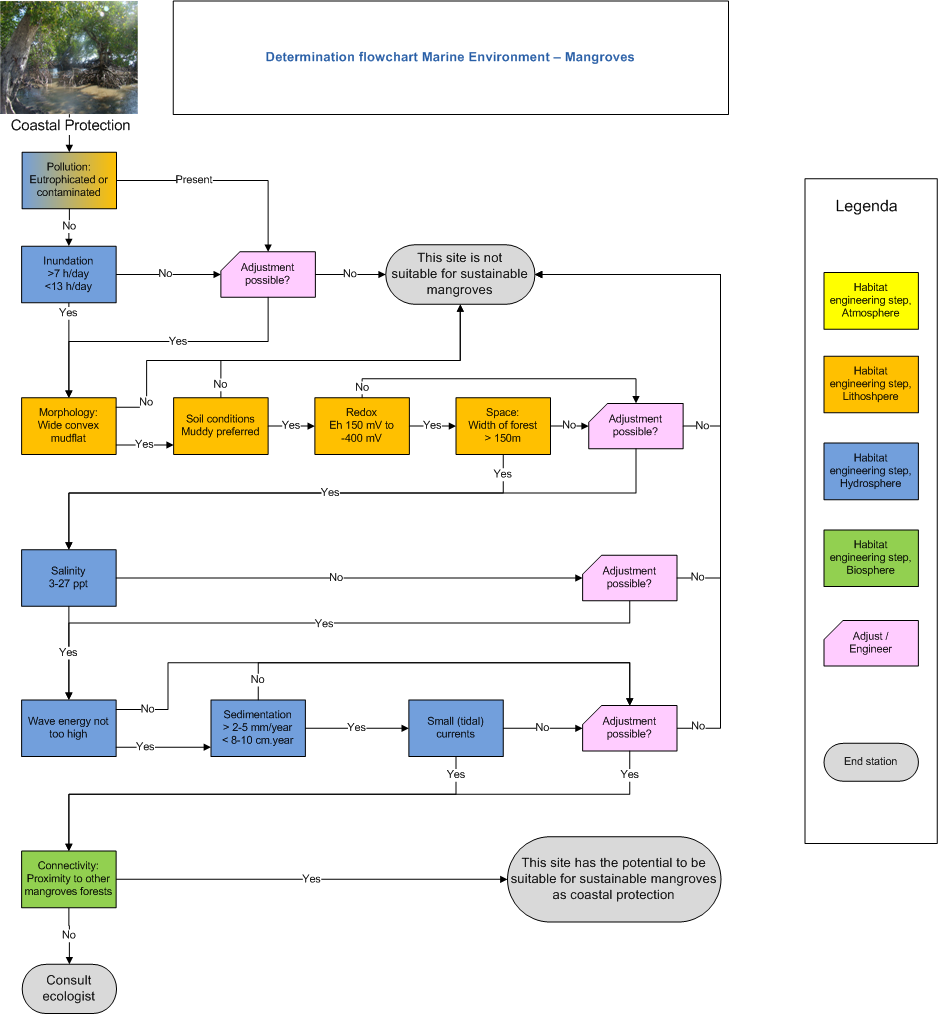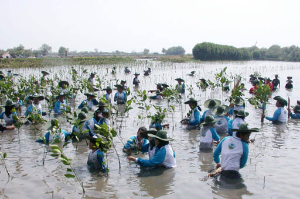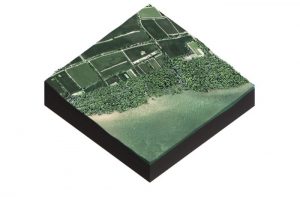How to Use
If an ecosystem engineer is considered to be included in a design for coastal protection or coastal rehabilitation, several questions need to be answered:
- Is it possible to create a suitable habitat for a specific ecosystem in the project area?
- What would be the envisaged (protection) services of this ecosystem?
- To what extent can the ecosystem contribute to the primary(protection) function of the design and how does this affect the design itself? For example, what dimensions of a mangrove forest are needed to reduce erosion or stabilize sediment? And what dimensions act as an efficient dissipator of wind and waves?
- What effects do the ecosystem engineers in this ecosystem have on the existing physical, ecological and socio-economical system?
- What are the costs, uncertainties and risks involved with including these ecosystem engineers in the design?
In this Concept, the focus lies on the habitat requirements for mangroves. The determination flowchart gives a first answer to the suitability of the project area as a habitat for mangroves. Other questions can be elaborated in subsequent or parallel steps.
Determination flowchart
The determination flowchart is based on the habitat requirements described in the general introduction. It comprehends the possibility for (natural) establishment of mangroves and the requirements to enable coastal protection. The function as coastal protector requires the ecosystem to be sustainable and robust. The goal of the determination flowchart is to give an easy, accessible and low-cost indication in an early stage of a project on whether a suitable habitat for mangroves exists or can be created. The flowchart can also be employed to determine if restoring or improving existing mangroves forests is an option, as it helps finding the possible causes of mangrove degradation or development stagnation.

The potential ecosystem services of mangroves are:
- The coastal protection value, e.g. erosion control and storm and flood protection by dissipating wave energy
- Water quality improvement by acting as a nutrient filter, by reducing turbidity via sediment trapping, etc.
- Providing a sustainable barrier which grows with (relative) sea-level rise by trapping sediments.
Other ecosystem services, such as provision, cultural and supporting services are not evaluated here.
Current Situation
Before employing the flowchart it is important to establish which (eco)system is present in the current situation and which function(s) it holds. Creating something new always comes at the cost of what presently exists. If a certain ecosystem is present, like a tidal flat, coral reef, seagrass meadow or salt marsh, it is necessary to understand that system in order to be able to prevent its degradation. Different communities may even enhance each other: a coral reef, for instance, can dissipate wave energy and create a sheltered area for seagrasses. The analysis of the current system should extend beyond the project site and consider adjacent systems. One reason is that coastal protection works usually have a large influence on the sediment budget and hence on adjacent coasts, another is that adjacent communities may produce seedlings for natural settling in the project area.
It is important to keep in mind that an existing (eco-)system may have other functions, such as cultural or supporting services, that may be lost by constructing something new. For example: creating a mangrove forest might be less attractive in a recreational area where people swim. If loosing the current functions is considered acceptable when a (new) mangrove forest providing the desired ecosystem services is created in return, the determination flowchart can be used.
The goal of the flowchart is to give the answer to the following question:
‘Does the intended project area have potential to (re-)establish a sustainable mangrove forest which provides the desired ecosystem services?’
The flowchart aims to indicate whether the important habitat requirements that allow establishment and sustainable presence of mangroves are naturally present or can be engineered. The result can only be a first-order indication, as the dynamics involved are too complex to comprise in a generic tool. When more precise information is needed in later project stages, local mangrove expertise should be called in.
Interpretation
Before employing the flowchart, several issues have to be considered. Firstly, mangroves only occur in tropical and subtropical environments. Secondly, the history of the proposed site can give a good indication on the suitability for creating a mangrove forest. If a mangrove forest was present in the recent history, and is now lost e.g. due to human activities, this can be an indication that the environmental conditions (salinity, wave exposure etc.) are suitable for creating or restoring a mangrove forest. The causes of disappearance can give insight in the habitat requirements which need to be adjusted or created. Finally, soil and water contamination will hamper mangrove establishment and growth. The possibility to remediate soil and water quality should be considered first, before going through the flowchart.
When going through the flowchart, note that comments are available to interpret the values provided. Keep in mind that every location is unique and has its characteristic dynamics, and that mangrove ecosystems are characterized by complex interactions. This makes defining exact thresholds a challenge, which may explain why many habitat requirements often remain unspecified.
Natural establishment vs. planting
This guideline can help to identify the main criteria determining the suitability of a site for natural recruitment of mangroves. Restoring the conditions which are favourable for natural establishment yields higher success rates of restoration projects than planting mangroves on any convenient mudflat. When mangroves establish naturally, natural competition and succession of species will result in a natural forest structure, density and species zonation. Associated fauna is an essential part of a sustainable ecosystem. For example pollinator species (e.g. bats) are essential for long term functioning of the forest, and so are burrowing crabs allowing soil oxygenation and flushing of excess salt from the soil. In case natural establishment is considered impossible by lack of propagule availability or dispersal, seeding or planting of mangrove trees can be considered. It is important to note that, in addition to the critical habitat requirements that need to be met, seedlings are more sensitive than mature trees and can withstand lower stress levels during the establishment phase (Balke et al, 2011). In the literature several guidelines are available which describe how mangroves should be restored. For more information, a set of literature on mangroves (and wetland) restoration is available and can also be found on the References section of this Concept.

A final remark on natural establishment versus planting: natural establishment will start with germination of pioneer species. They will be succeeded and supplemented by middle zone species. After one year pioneer species can already be one meter high and function as a wave energy dissipator. From that moment on, the moment the mangrove forest starts to function as a coastal protection component. The effectiveness of the coastal protection function depends on the density of the forest, its age and the species in it. In Singapore, maturation of the forest after natural seedling establishment takes about 6 years (Lee et al., 1996).

